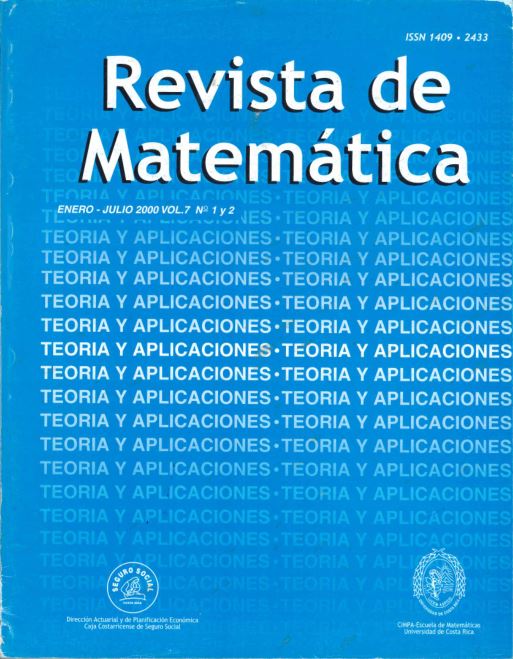Resumen
Los procesos aleatorios son controlados (monitoreados) sobre el espacio y el tiempo por una red de estaciones distribuidas a lo largo de una región espacial. Información auxiliar es recogida a menudo no solamente en las estaciones sino también en otros puntos de la región. La incorporación de información auxiliar en algunas técnicas de interpolación ha mostrado que los resultados de la interpolación se mejoran. El modelo de Funciones Emṕıricas Ortogonales (EOF) es una conocida técnica de predicción basada en vectores propios, usada ampliamente en meteoroloǵıa y oceanograf́ıa para modelar la variabilidad de procesos estocásticos espacio-temporales observados. Se construyen matrices de similitudes usando información auxiliar disponible e incluida en el modelo EOF para desarrollar un método de interpolación espacial. La técnica de interpolación resultante será aplicada a un conjunto de datos reales y los resultados serán comparados al ‘kriging’ ordinario.
Citas
Bobrowiz, O.; Choulet, C.; Haurat, A.; Sandoz, F.; Tebaa, M. (1990) A method to build membership functions. Application to numerical/symbolic interface building, Lecture Notes in Computer Science, 521. Springer-Verlag, New York: 136–142.
Buell, C. E. (1971) “Integral equation representation for Factor Analysis”, Journal of Atmospheric Sciences 28: 1502–1505.
Clarke, J. F.; Edgerton, E. S.; Martin, B. E. (1997) “Dry deposition calculations for the clean air status and trends network”, Atmospheric Environment 21: 3667–3678.
Cressie, N.A.C. (1991) Statistics for Spatial Data. John Wiley & Sons, New York. Daly, C.; Neilson, R.P.; Phillips, D.L. (1994) “A statistical-topographic model for mapping climatological precipitation over mountainous terrain”, Journal of Applied Meteorology 33: 140–158.
Dubois, D.; Prade, H. (1980) Fuzzy Sets and Systems, Theory and Applications. Mathematics in Science and Engineering, 144, Academic Press, New York.
Duckstein, L.; Blinowska, A.; Verroust, G. (1995) “Fuzzy classification of patient state with application to electrodiagnosis of peripheral polyneuropathy”, IEEE Transactions on Biomedical Engineering 42(8): 786–792.
Erickson, R.; Di Lorenzo, P.M.; Woodbury, M.A. (1994) “Classification of the taste responses in brain stem: membership in fuzzy sets”, The American Physiological Society: 2139–2150
Everitt, B.S. (1993) Cluster Analysis, 3rd Edition. Edward Arnold, London. Fang, J.H. (1997) “Fuzzy logic and geology mathematical modeling in geological systems”, Geotimes 42(10): 23–26.
Gower, J.C. (1971) “A general coefficient of similarity and some of its properties”, Biometrics 27: 857–874.
Guerra, T.M.; Loslever, P. (1993) “Two ways for getting connections between objective and subjective data sets in man-machine systems: multiple correspondence factor analysis and probabilistic fuzzy set theory”, Cybernetics and Systems: An International Journal 24: 217–242.
Hendricks, F.; van Eijnsbergen, A.C.; Stein, A. (1997) “Use of spatial prediction techniques and fuzzy classification mapping soil pollutants”, Geoderma 77: 243–262.
Hersh, H.M.; Caramazza, A. (1976) A fuzzy set approach to modifiers and vagueness in natural language”, Journal of Experimental Psychology: General 105(3): 254–276.
Hewitt, C.N. (1992) Methods of Environmental Data Analysis. Elsevier, Dordrecht.
Holland, D.M.; Principe, P.P.; Vorgurger, L. (1999) “Rural ozone: trends and exceedances at CASTnet sites”, Environmental Science and Technology 33: 43–48.
Juang, C.H.; Huang, X. H.; Holtz, R.D.; Chen, J. W. (1996) “Determining relative density of sands from CPT using fuzzy sets”, Journal of Geotechnical Engineering, January: 1-6.
Legendre L.; Legendre P. (1983) Numerical Ecology, Developments in Environmental Modelling 3. Elsevier, Dordrecht.
Legge, H. A.; Krupa, S.V. (1990) Acidic Deposition: Sulphur and Nitrogen Oxides. Lewis Publishers
Leung, Y. (1988) “Spatial analysis and planning under imprecision”, Studies in Regional Science and Urban Economics 14: 66–139.
Muñoz-Hernández, Breda; Lesser, V.M.; Ramsey, F.L. (1999) “Design based empirical orthogonal functions”, Proceedings of the Section of Statistics and the Environment, American Statistical Association.
Obled, Ch.; Creutin, J.D. (1986) “Some development in the use of empirical orthogonal functions for mapping meteorological fields”, Journal of Climate and Applied Meteorology 23(9): 1189–1204.
Okabe, A.; Boots, B.; Sugihara, K. (1992) Spatial Tessellations. Concepts and Applications of Voronoi Diagrams. John Wiley & Sons., New York.
Pleim, J.E.; Finkelstein, P.L.; Clarke, J.F.; Ellestad, T.G. (s.f.) “A technique for estimating dry deposition velocities based on similarities with latent heat flux”, Atmospheric Environment 33: 2257–2268.
Preisendorfer, R.W. (1988) “Principal component analysis in meteorology and oceanography”, Developments in Atmospheric Science 17: 192–199.
Robeson, S.M. (1997) “Spherical methods for spatial interpolation”, Review and Evaluation, Cartography and Geographic Information Systems 24(1): 3–20.
Watson, D.F.; Philip, G.M. (1987) “Neighborhood-Based Interpolation”, Geobyte 2(2): 12–16.
Wikle, C.K. (1996) Spatio-Temporal Statistical Models with Applications to Atmospheric
Processes. Ph.D. dissertation, Iowa State University, Ames, Iowa.
Wikle, C.K.; Cressie, N. (1997) “A dimension-reduction approach to space-time Kalman filtering”, Preprint No.97-2, Statistical Laboratory, ISU, Iowa State University, Iowa.
Willmott, C. J.; Robeson, S. (1995) “Climatological aided interpolation (CAI) of terrestrial air temperatures”, International Journal of Climatology 15 221–229.
Willmott, C. J.; Matsuura, K. (1995) “Sart Interpolation of annually averaged air temperature in the United States”, Journal of Applied Meteorology 34: 2577–2586.
Wirsam, B.; Uthus, E. O. (1996) “The use of fuzzy logic in nutrition”, American Institute of Nutrition: 2337S–2341S.





